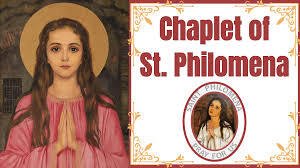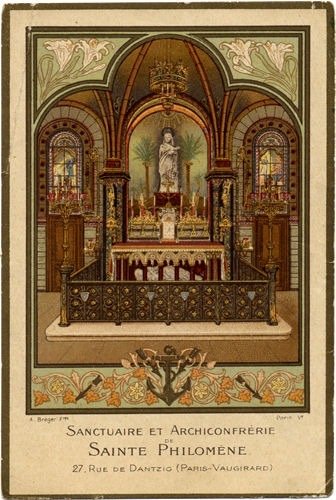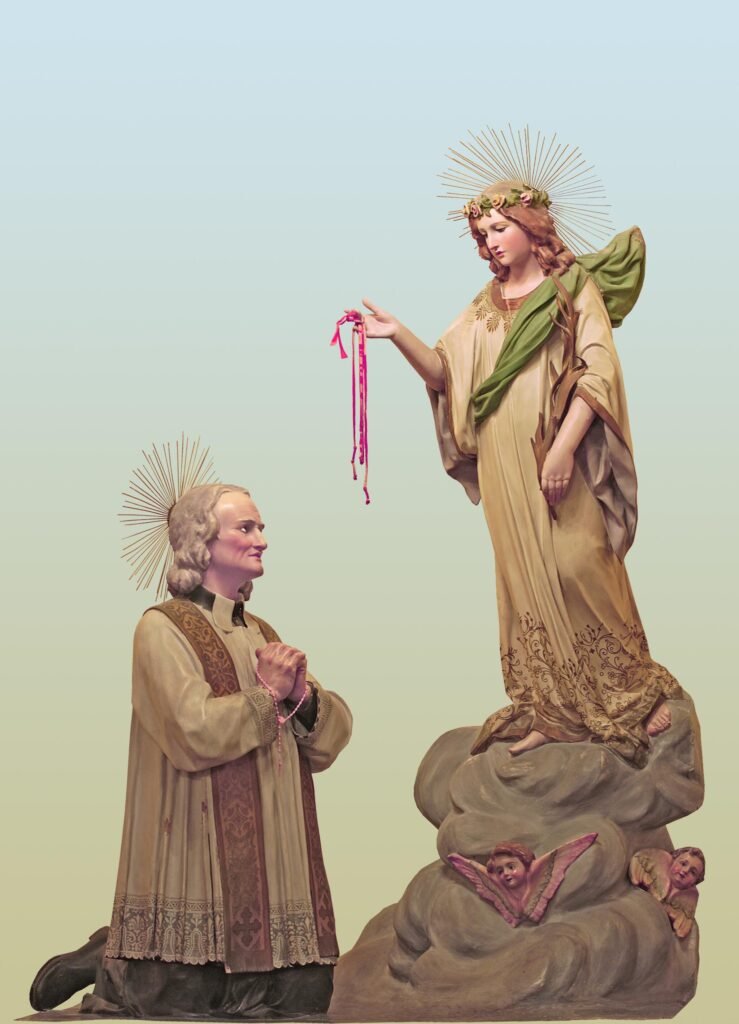
The Chaplet of Saint Philomena
The chaplet also known as the rosary or Little Crown of St. Philomena was founded by the Holy Curé of Ars and consits of red beads to signify Her martyrdom and white beads, a token of Her Virginity and Purity.
This Rosary is one of the simplest ways of praying to the Saint. First the creed is recited on the Crucifix or medal of Saint Philomena to ask for the gift of Faith. Three Our Fathers on each of the white beads to thank the Blessed Trinity for the gifts given to the Holy Virgin, for in whose honour, laid down Her life. The red beads are thirteen in number and signify the 13 years our Martyr lived on earth and this prayer is recited on each bead:
Hail, O Holy St. Philomena, whom I acknowledge, after Mary, as my advocate with the Divine Spouse; intercede for me now and at the hour of my death. St. Philomena, beloved daughter of Jesus and Mary, pray for us who have recourse to thee. Amen.
This prayer may be substituted for 13 Hail Mary’s each followed by: Saint Philomena, pray for us!
At the end say: Hail, O Illustrious Saint Philomena, who so courageously shed thy blood for Christ, I bless the Lord for all the graces He has bestowed upon thee, during thy life, especially at thy death, I praise and glorify Him for the honour and power with which He has crowned thee, and I beg thee to obtain for me from God the graces I ask through thy intercession. Amen.
The Oil of Saint Philomena
In 1805 when the Sacred Body of Saint Philomena was enshrined in Mugnano del Cardinale, it was the custom to burn an oil lamp in front of the body of a Martyr or Saint. As the word rapidly spread of the Virgin Martyr who had arrived in this small Italian town, many people came to the church to pray.
One local woman, full of faith in God, dipped her finger in the oil lamp and anointed the eyelids of her blind child. To the astonishment of all present, the child’s sight was immediately restored. This miracle took place on August 18, 1805, only eight days after Philomena’s body arrived in Mugnano. This event has been recorded as the first Miracle of the oil from the lamp which burns in front of the Sacred Body of St. Philomena.
However, the practice of the use and distributing the oil of Saint Philomena has an ancient precedent set by St. jean Vianney, as he would also send oil from the lamps burnt before the statue and relic of Saint Philomena enshrined in his chapel in Ars to devotees all over France.
One example of a cure due to the use of this oil is as follows: In 1859, the Baroness van Caloen, who lived in Bruges, wrote to St. Jean Vianney asking him to pray for her son Joseph, who was six years old and unable to walk because he had a huge bone growth under his right knee. Have confidence in God,” the Curé d’Ars replied, “and start a novena to Saint Philomena. You will have to anoint the ailment twice a day with the oil sent to you, while you recite the prayers to the saint as a family.”
Joseph, who had become Bishop of Phocaea and Archbishop of the Benedictine Congregation in Brazil, wrote: “We punctually followed Mr Vianney’s prescriptions. Little by little we saw the growth diminish, to such an extent that by the last day of the novena there was no trace of it left.”

Historical precedent of the distribution of the Oil of Saint Philomena by the Archconfraternity
The practice of the use of the oil of St. Philomena spread elsewhere in the country of France, and later, like the Cord of Saint Philomena, the Oil of Saint Philomena was made famous by the Archconfraternity as it distributed it around the world.
Fr. O’Sullivan writes of one such example in his book ‘Saint Philomena: Wonderworker’
“In Paris the devotion began very simply. A gentleman who had received a striking favor from Saint Philomena offered an image of the Saint to the Church of Saint Gervais. This was exposed for the veneration of the faithful, who speedily had reason to recognize in the abundance of favors received the extraordinary power of the new Saint. The cult of the Saint increased so rapidly that in a short time it was found necessary to dedicate one of the side chapels in her honor.
Crowds attended the devotion, and during the novena in preparation for the feast, the church was filled to overflowing by multitudes of the faithful. Many are the stories recounted by the clients of the Saint of the marvels she worked for them. Cures and conversions became frequent; blessings, temporal and spiritual, were received; astounding answers to prayer became so numerous as to cease to cause surprise.
During the time of the Paris Commune (May, 1871), her protection was most especially manifested. The outrages perpetrated in the close vicinity of Saint Gervais were some of the most horrible that took place at this awful time. The communists made several efforts to destroy the church itself but were always foiled in their nefarious attempts. Finally they came in great force under cover of darkness and commenced a thorough sack of the building. All seemed lost when, strange to say, one of their own number hastened for help and drove them out of the sacred edifice.
Though all the buildings in the neighborhood became one vast conflagration, Saint Gervais alone stood intact, a silent but eloquent witness to the power of Saint Philomena.
Thirteen lamps burn by day and night on the altar, commemorating the thirteen years of the mortal life of the Saint. The oil from these lamps is frequently demanded for use by the sick, and very remarkable indeed are the cures it effects. Each evening a special service is held in honor of the Saint, consisting of prayers, Benediction of the Blessed Sacrament and frequently a panegyric [sermon of praise] on the Saint. The Archconfraternity of Saint Philomena established in the church counts upwards of 8,000 members.
As it is practiced today, Members of the Archconfraternity donated oil to be blessed and distributed worldwide, with its manual instructing members where to request Oil for those who are in need of it. The tradition of the blessing of this oil had been handed down through generations until it’s revival in modern times.
The Revival of the practice by Msgr. Giovanni Braschi in 1987 as President of the Archconfraternity and is also Rector of the Sanctuary.
Each year in January, the local Bishop and the Rector of the Sanctuary participate in the blessing of the oil of St. Philomena. Pilgrims process to the Sanctuary, donating the oil and placing it in front of the Sacred Body. The oil is then blessed and distributed worldwide in the familiar red container bearing the name of the Sanctuary.
The Universal Archconfraternity of Saint Philomena, on hearing the needs and challenges of her members worldwide, and observing the increased demand for the Oil of our dear patroness, plans to establish local authorised sources for the Oil of Saint Philomena, which are blessed by our appointed spiritual directors before her sacred relics and distributed via Official Archconfraternity Centers throughout the world for those who request it.
Since the Oil of Saint Philomena is a sacramental, as per canon law concerning the dispersal of holy objects – it cannot be sold. In fact, we recently discovered from our research that The Manual of the Archconfraternity of Sant Philomena states that objects sold lose their indulgences!
Therefore, we advise you not to buy any Oil found online in stores like Ebay, Etsy, etc.
However, donations to support the work of The Universal Archconfraternity of Saint Philomena is welcome. As it helps us to provide the Oil for those who may not be able to afford to pay for postage.
Meanwhile, you can still request the Oil of Saint Philomena from the following:
1. From your nearest Archconfraternity centre (where available)
2. From the Universal Living Rosary Association
3. From the Sanctuary of Saint Philomena. Important: please note The Sanctuary of Saint Philomena have their own policies and practices of distribution of the Oil of Saint Philomena, and will differ from ours. Therefore we cannot answer any queries for the Sanctuary.
Use of the Oil of Saint Philomena
A devotional blessing with the Oil of St. Philomena may be given by a priest or lay devotee as long as its use is within the prayerful intention of the Church as a sign of divine blessing and an expression of faith.
For example: In a liturgical setting such as Mass, healing service, etc, ONLY a Bishop, Priest, and deacon may bless individuals with the Oil as this is proper to their state.
Lay members (with the permission of the competent authority) may anoint only within the conditions and prescribed rules of the church proper to their state – in any situation, laity anointing with the oil can only do so to join in prayer with an individual to ask God to bless or heal them. Laity have no power or authority to bless people. (with the exception of parents blessing their children).
Laity should not preside in a liturgical setting as this is only proper to clergy.
The anointing may be given on the forehead and the following prayer may be recited.
Prayer to St. Philomena for use with her blessed oil:
O St. Philomena,
Virginal bride of Jesus and daughter of Mary Immaculate,
as we bless ourselves with your holy oil,
we invoke your powerful intercession
for heroic purity of heart
and the perfection of Christian love.
May its use strengthen our souls and heal our bodies
according to God’s perfect will.
Dear St. Philomena, model of purity and icon of courage,
especially for the youth of today,
pray for us that God may grant to our hearts
a martyr’s courage under persecution,
a holy purity of mind and body,
and a heroic love for Jesus,
our divine Lord and Master.
Amen

THE BLESSED CORD OF ST PHILOMENA
The pious practice of wearing the Cord of St Philomena was born spontaneously amongst the Saints’ devotees. The Cord was first distributed by St. Jean Vianney, Cure of Ars who was seen on numerous occasions being presented with the Cord for his blessing.
Following the death of the saintly Cure of Ars, In 1883 Abbe louis petit (whom Pope Leo XIII received several times in audience) petitions the Holy See to formally approve the cord of St. Philomena. On December 15th his request was granted when the Sacred congregation of Rites approved the wearing of her Cord of two colours, white and red, symbols of virginity and martyrdom, which Abbe Louis Petit promoted through his monthly publication, ‘The Messenger of St. Philomena’.
In his other works, Abbe Louis Petit informs us The following year the cord was granted more graces on April 3rd 1884, approximately two months after founding of the ‘The work of Saint Philomena’, when Pope Leo XIII consecrated the Cord in perpetuity by deputing a religious family to bless it with the application of indulgences. This religious family was none other than The Religious of St. Vincent de Paul of which Abbe Louis Petit was an ordained priest, whose home was the church of Notre Dame de la Salette in Paris, where the then newly canonically erected Confraternity was born.
Later on, May 2 1884, the Holy Father further indulgenced the cord with graces and benefits, extending this form of devotion to the Universal Church, and therefore formally authorized the ‘Work of Saint Philomena’ (and those whom they permit) to distribute the cord worldwide.
Here marks the point where ‘The Cord of Saint Philomena’ is forever entwined with our history, becoming both its sacramental and attire as an expression of our spirituality and devotion to our dear little saint, both celebrating, and aiming to imitate the virtues of our beloved protector and patroness. Therefore members of The Universal Archconfraternity of Saint Philomena are encouraged to wear the cord as it is a sign of membership of this worldwide ‘Family of Saint philomena’, and part of our unique Philomenian identity.
How to obtain the Cord of Saint Philomena:
The Cord of Saint Philomena can be obtained by the following means:
1. From your local Universal Archconfraternity center or,
2. Your local Universal Living Rosary Association Center, who are authorized to distribute it. Or,
3. The Sanctuary of Saint Philomena (Important: please note The Sanctuary of Saint Philomena have their own policies and practices of distribution of the Cord of Saint Philomena which differ from ours. Therefore we cannot answer any queries for the Sanctuary).

Instructions for the Cord of Saint Philomena
- The Cord is made with either cotton, linen or wool and must be white and red in color, with two knots at one end in honor of Her title of Virgin and Martyr.
- Any priest, authorized by The Universal Archconfraternity of Saint Philomena, has the faculty to bless the Cord of Saint Philomena using the Roman Ritual formula.
- There is also a historical blessing and investiture ceremony associated with the Cord of Saint Philomena which we will make available to our Spiritual Directors to revive which we will announce the details of soon.
- The Cord should be worn under the clothes like a belt, although there are small Cords which a child or adult can wear around the wrist, and the following prayer should be said every day: –
PRAYER TO ST PHILOMENA
O St Philomena, Virgin and Martyr, pray for us so that through your powerful intercession we may obtain that purity of spirit and heart the leads to the perfect love of God. Amen.
The Cord is both a symbol and a prayer.
- A symbol because we bind ourselves to St Philomena with sincere devotion
- A prayer because in wearing the cord we pray to St Philomena to protect us in every moment of our lives.
The purpose of the devotion is therefore
- To obtain through the intercession of St Philomena, Her protection against the evils of soul and body.
- To increase and reinforce the spirit of our faith.
- To show a special love for St Philomena and seek her protection at all times.
Observances to obtain this purpose
- Wear the blessed Cord with devotion as a sign of the duty we have accepted to conserve saintly purity and to defend the faith.
- Devote oneself to prayer in order to imitate St Philomena.
- Flee from all occasions that endanger our purity.
Honor the feasts of St Philomena, receiving Holy Eucharist on these days: –
10th January, Her birth,
25th May, the anniversary of the discovery of Her precious bones,
10th August, the anniversary of her glorious death,
11August the principal feast day,
13 August, her name day celebrate the month of St Philomena
from 1st July until 10th August in honor of the 40 days she spent imprisoned.
Keep an image of St Philomena in one’s home and honor her every day.
On 3rd April 1884 Pope Leo XIII enriched the wearing of the Cord with special indulgences as follows: –
100 days of indulgence to the faithful who wear the Cord and recite the prayer with devotion and contrition.
Plenary indulgences
- On the day on which the Cord is worn for the first time.
- On 25th May, the anniversary of the discovery of the body of St Philomena in the catacombs of St Priscilla.
- On 11th August Feast of St Philomena
- On 15th December, the anniversary of the approbation of the Cord by the Holy See.
- At the moment of death.
The Cord of St Philomena will protect:
- Christian virgins from the temptations of the world today.
- Christian mothers who consecrate their children to St Philomena at the baptismal font and dress them with the Blessed Cord will never weep for their lost innocence.
- Those who are sick and wear the Blessed Cord and have faith in its healing powers will regain health of body and soul.
The following prayer can be said whilst wearing the cord, to obtain recovery from illness:
St Philomena who has endured many cruel tortures for Jesus Christ. Grant me the patience to bear this illness and if it be God’s will, let me, wearing the Cord blessed in your name, recover good health to enable me to work towards the sanctification of my soul. Amen
Plenary indulgences
Only authentic Catholic devotions and practices should be observed. Generally, it is recommended that devotions should not be mixed, unless they are connected or associated with St. Philomena in some way. E.g. Praying the Rosary, asking for the intercession of St. Jean Vianney, Blessed Pauline Jaricot, etc.
Religious Syncretisim (mixing of devotional or worship practices from other religions) is prohibited by the church. Practices such as the use of the enneagram, meditation and mindfulness techniques such as ‘centering prayer’ (the version drawn from eastern spirituality), spiritualism, angelology (angel worship), voodoo/hudu, wicca practices (such as ritual offerings to saints & spells), the use of charms & healing crystals is prohibited by the church, and therefore not to be promoted or practiced by Centers, its representatives or members of the Universal Archconfraternity of Saint Philomena.
Messages from apparitions and seers prohibited or not approved by the church are not to be promoted in the Archconfraternity (e.g. Vassula Rydens, ‘True Life in God’, ‘Maria Divine Mercy’ and her ‘Book of truth’ and the ‘seal of the living God’, and medals.)
Individuals who claim to experience private revelations or apparitions from Saint Philomena and other religious figures are instructed to refrain from promoting them in within the Universal Archconfraternity, and are encouraged to seek the assistance of a Spiritual Director, and to submit in humility and obedience to the proper process and competent authorities within the church to investigate such phenomena in order to discern between genuine and false apparitions and messages.
As a canonically erected Universal Archconfraternity we are bound by, and obey canon law requirements of our organisation, including investigations and judgements concerning devotional practices, messages and apparitions elsewhere in the Catholic church.

